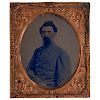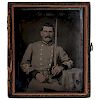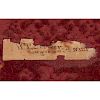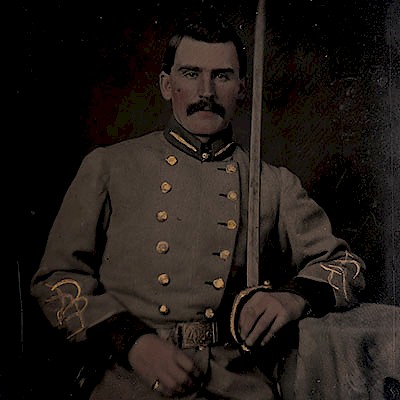Surgeon William T. Brewer, 43rd NCST, Captured at Gettysburg, Two Exquisite Sixth Plate Ambrotypes, Inc. Rare Blue Ambrotype
About Seller
6270 Este Ave.
Cincinnati , OH 45232
United States
With offices in Cincinnati, Cleveland and Denver, Cowan’s holds over 40 auctions each year, with annual sales exceeding $16M. We reach buyers around the globe, and take pride in our reputation for integrity, customer service and great results. A full-service house, Cowan’s Auctions specializes in Am...Read more
Two ways to bid:
- Leave a max absentee bid and the platform will bid on your behalf up to your maximum bid during the live auction.
- Bid live during the auction and your bids will be submitted real-time to the auctioneer.
Bid Increments
| Price | Bid Increment |
|---|---|
| $0 | $25 |
| $500 | $50 |
| $1,000 | $100 |
| $2,000 | $250 |
| $5,000 | $500 |
| $10,000 | $1,000 |
| $20,000 | $2,500 |
| $50,000 | $5,000 |
| $100,000 | $10,000 |
About Auction
Jun 22, 2018
Cowan’s American History: Premier Auction, scheduled for June 22, 2018 is comprised of early photographs, documents, manuscripts, broadsides, flags, and more dating from the Revolutionary War, the Civil War, Late Indian Wars, World War I and II and beyond. Cowan's Auctions dawnie@cowans.com
- Lot Description
A pair of rare sixth plate ambrotypes capturing the visage of a Confederate Surgeon who was captured at Gettysburg and surrendered with the regiment at Appomattox. The brass matted, blue-tinted ambrotype of a stern-looking William T. Brewer sporting fashionable goatee is housed in the original composition case with a period ink identification, "W.T. Brewer/Surgeon 43rd N.C.S.T.," on a slip of distressed paper affixed to the pillow. The companion portrait of a more sanguine junior officer shouldering a Boyle & Gamble sword was found loose, "laying underneath." This plate is the earlier of the two, probably taken at Raleigh by an anonymous photographer shortly after Brewer was appointed 2nd lieutenant on February 28, 1862. Brewer's immaculate double breasted frock coat with two rows of seven buttons is straight Confederate regulation with branch of service (infantry) blue collar and cuffs, a single collar bar denoting 2nd lieutenant and corresponding thin lines of "chicken guts" sleeve braid. The rectangular brass belt plate in relief appears to be a pre-war militia pattern. Later appointed assistant surgeon in April 1862 and regimental surgeon in February 1863, the stark blue-tinted plate of Brewer wearing a plain frock coat with a gold major's star on the collar is from that period. Both ambrotypes are in near excellent condition with strong clarity, one plate with minor spotting.
William T. Brewer (b. abt.1834-?) was a recent 1859 graduate of Jefferson Medical College in Philadelphia and a practicing Physician in Wilson County, North Carolina when he enlisted in February 1862. Twenty-eight year old Brewer was soon commissioned in Company C as a precursor to being appointed assistant surgeon of the 43rd NCST then organizing at Camp Mangum near Raleigh. The regiment was initially assigned to the Department of North Carolina and saw its first action as part of Junius Daniel's Brigade during the Seven Days' Battles, being heavily bombarded by Federal gunboats on the James River at Malvern Hill. The regiment served at Drewry's Bluff during the Sharpsburg Campaign and was later posted to Kinston, North Carolina as part of the relief force sent to the aid of Washington, North Carolina. In May 1863, Daniels's Brigade was assigned to D.H. Hill/Robert Rodes' Division in Ewell's 2nd Corps, Army of Northern Virginia for Lee's invasion of Pennsylvania. Marching on the Mummasburg Road, contact was made with the right flank of the Federal 1st Corps just outside of Gettysburg. Early in the afternoon of that July 1, Daniel's Brigade acted in support of Iverson's advanced brigade, forming up on open ground and drawing desultory artillery fire. Orders then given by Rodes' to his attacking brigadiers - Iverson and O'Neal - were apparently misunderstood resulting in an uncoordinated assault by just three of O'Neal's regiments that was repulsed with heavy casualties. Advancing to the support of Iverson through the smoke of battle while taking enfilade fire, Daniel's was compelled to divide his brigade and ended up attacking two Union positions simultaneously. By the end of the first day's fighting at Gettysburg the tenacious defense of the 1st Corps had crumbled and the exhausted men of the 43rd North Carolina found themselves "in and near" the bloody Railroad Cut having suffered 120 killed, wounded, and missing during the afternoon. On July 2, the 43rd supported a battery just north of the Seminary before taking position on the southern edge of town and bivouacking for the night. Before dawn on July 3 Daniel's brigade was ordered to the extreme left of the Confederate line and took part in the grand attack on Culp's Hill where "they occupied the earthworks abandoned by the Union troops." The momentum of the advance carried beyond the earthworks but was soon met by devastating Union canister fire at close range causing over fifty casualties in short order. During the battle the brigade hospital had been located in the rear near the scene of the first day's fighting at the Hankey Farm on the Mummasburg Road. Here, the mounting casualties were collected and treated but no contemporary account of what must have been an appalling scene has survived as an anecdote to Surgeon Brewer's grisly work. What is known is that Surgeon Brewer, one of ten medical officers in Rodes' Division, voluntarily remained behind while Lee's army disengaged and commenced to retreat. An eye-witness account found in the 1956 book, Rebel Boast: First at Bethel, Last at Appomattox by Manley Wade Wellman relates that, "Union cavalry had rushed the ambulance train on the evening of July 4, had cut off some of the wagon loads of wounded" resulting in Surgeon Brewer "falling into enemy hands."The incident is confirmed and amplified in Retreat from Gettysburg: Lee, Logistics, and the Pennsylvania Campaign published in 2005.
Several hundred Confederate medical personnel including Surgeon Brewer were initially confined at Fort Monroe, Virginia on July 30, 1863. Brewer was later transferred to the officers prison at Fort McHenry in Baltimore Harbor on August 10, 1863 where he and others waited impatiently through the fall until finally being paroled at City Point, Virginia on November 21, 1863. Brewer is reported as having returned to the regiment on January 1, 1864. Thereafter, Surgeon Brewer served for the duration including Cold Harbor, detached operations with Jubal Early in the Shenandoah, notably Winchester, and the final Appomattox Campaign where he was one of nine officers of the 43rd North Carolina who surrendered. Contemporary accounts of Surgeon Brewer paint the picture of an ill humored if not acerbic young man. One observer who served with Brewer recalled, "He says he was treated miserably by the authorities, but could get what he wanted from the citizens, says the wounded Yankees that fall into his hands may take care for their limbs, for upon the slightest wound he would take them off." Another wounded soldier named George Wills recounted an exchange with Surgeon Brewer who rather unsympathetically inquired of Wills, "Is it not hard to be only half a man?" Private Wills regarded Brewer as "never too kind to patients." Another observer wrote flatly that "Brewer was a gruff but competent military Surgeon" - useful as an epitaph of sorts and certainly reflected in the blue-tinted Brewer ambrotype portrait. Regrettably, information that might add dimension to the post-war life and career of William T. Brewer could not be found, and nothing regarding his death or burial could be located.
Eliminate the Hassle of Third-Party Shippers: Let Cowan's Ship Directly To You!Condition
If you'd like a shipping estimate before the auction, contact Cowan's in-house shipping department at shipping@cowans.com or 513.871.1670 x219. - Shipping Info
-
Buyers are required to pay for all packing, shipping and insurance charges. Overseas duty charges are the responsibility of the successful Bidder. Be aware that for larger and/or valuable items, shipping charges can be substantial. - If there is no shipping amount on listed your invoice, you will need to make arrangements to pick up or ship your purchase through an alternative shipping company. Our shipping department can be contacted at 513.871.1670 (ext. 219) or email shipping@cowans.com. - Shipping charges include insurance for your order while in transit. If you have private insurance we will adjust your charge to include only packing and shipping. - Please allow 14 – 21 days after payment to package and ship your purchase as carefully as possible.
-
- Buyer's Premium



 EUR
EUR CAD
CAD AUD
AUD GBP
GBP MXN
MXN HKD
HKD CNY
CNY MYR
MYR SEK
SEK SGD
SGD CHF
CHF THB
THB














